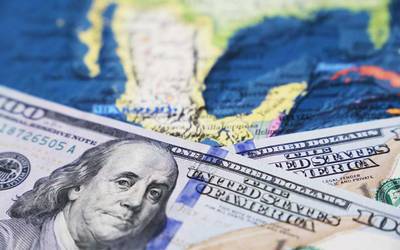The peso begins the session with an appreciation of 0.25% or 5 cents, trading around 19.75 pesos per dollar, with the exchange rate touching a minimum of 19.7495 and a maximum of 19.8576 pesos.
The Mexican peso is once again one of the most appreciated currencies in the session, only behind the Russian ruble, which advanced 0.38 percent.
Likewise, the appreciation of the peso is due to a lower perception of risk with respect to Mexico associated with the preliminary results of the federal elections in Mexico, where the party at the head of the executive power and its allies did not obtain a qualified majority in the Chamber of Deputies, which reduces the likelihood of changes to the constitution.
It should be remembered that in previous months the markets had reacted negatively to the possibility of reforms to the INE or the Banco de México , which could compromise future democratic processes or the autonomy of the central bank respectively.
In the exchange market, the dollar strengthens against most of its main crosses, advancing 0.09%, while the market is waiting for relevant economic information during the week, mainly the inflation of the United States corresponding to May that is published this Thursday and that Grupo Financiero Base estimates that it could be at 4.8% annually, rising from 4.2% in April.
Mexican peso
Confirmation that inflationary pressures are greater than expected could again lead to speculation that the Federal Reserve may reduce its broadly flexible monetary position early, starting by cutting the bond purchase program.
This has a strengthening effect on the dollar in the exchange market.
Today little relevant economic information is published, highlighting in the United States the trade balance of goods and services for April, which showed a deficit of 68.9 billion dollars, decreasing at a monthly rate of 8.2 percent.
In the interior, exports increased at a monthly rate of 1.1% while imports decreased 1.4 percent.
In April, global demand was supported by progress in vaccination campaigns, which allowed the lifting of restrictions in some businesses, especially in the services sector.
However, due to higher demand, bottlenecks are being observed in supply chains, as there are shortages of certain inputs, which limits trade.
Additionally, the foregoing has caused a general increase in the prices of raw materials.
International trade
In the accumulated of the first four months of the year, the main commercial partner of the United States is Mexico, having 14.8% of trade with the United States, followed by Canada with 14.4%, China with 14.0%, Japan with 4.8% and Germany with 4.5 percent.
Specifically in April, the main trading partner of the United States was also Mexico, representing 14.7% of the international trade of the United States this month.
During the session, the exchange rate is expected to trade between 19.71 and 19.90 pesos per dollar.
The euro starts the session with a depreciation of 0.02%, trading at 1.2187 dollars per euro, while the pound loses 0.20%, settling at 1.4154 dollars per pound.
Money market and debt
In the United States, the yield on the 10-year Treasury bonds shows a decrease of 5.3 basis points, reaching 1.52%, while in Mexico the yield on the 10-year M bonds remains unchanged at a rate of 6.55 per hundred.
Derivatives market and peso
To hedge against a depreciation of the peso beyond 20.00 pesos per dollar, a purchase option (call), with an exercise date within 1 month has a premium of 1.44% and represents the right but not the obligation to buy dollars in the aforementioned level.
On the other hand, the interbank forward for sale is at 19.8186 at 1 month, 20.1631 at 6 months and 20.6363 pesos per dollar at one year.
Gabriela Siller; PhD
Director of Economic-Financial Analysis.
Banco BASE
![]()

